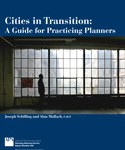 APA’s PAS Reports (Cities in Transition, PAS 568) (Sustaining Places, PAS 567)
APA’s PAS Reports (Cities in Transition, PAS 568) (Sustaining Places, PAS 567)
In a recent APA Sustaining Places blog by David Morely (“Is Growth a Prerequisite for Long-Term Community Health and Prosperity?”), the old assumptions of growth and decline of cities and communities in relationship to their health and prosperity are revisited. David discusses how the growth oriented planning model has for too long the been the modus operandi and the dominant planning ideology in the United States.
In practice, the growth model has operated in the U.S. like so called common sense has for Marx; who saw common sense as a way for an dominant or a particular political (or class order) to turn its construction of reality (example, prosperity through growth) into a neutral set of ideas, which are then taken as givens of the natural order.
As the growth model operates silently, unchallenged under various planning efforts, it uses “new development” as its operating fuel (i.e. more roof tops, more people, often more land, more widgets). As a result, planning and economic development programs are then geared towards accommodating the very growth he program is planning for. As David points out, when the paradigm falls short and the development never arrives, plans and visions fail to come to fruition.
The classic growth model simply no longer serves many communities who have “suffered decades of depopulation and disinvestment due to sprawl, deindustrialization, or Sun Belt migration.” Enter, APA’s latest PAS Report on Cities in Transition (PAS 568) by authors Joseph Schilling and Alan Mallach, FAICP. As with all PAS reports, this is really meant to be a practitioners guide and it’s chalk filled with clarity, tips and lessons (via case studies and interviews peppered throughout the report with folks learning by doing, in cities in transition).
David aptly notes the key theme of Cities in Transition “is that planners working in these cities need to embrace a new paradigm based on sustainability instead of growth. As Schilling and Mallach explain: “This is not planning for shrinkage but planning that recognizes shrinkage as the reality and a starting point for thinking about the future.”
